#darrow westerns
Text

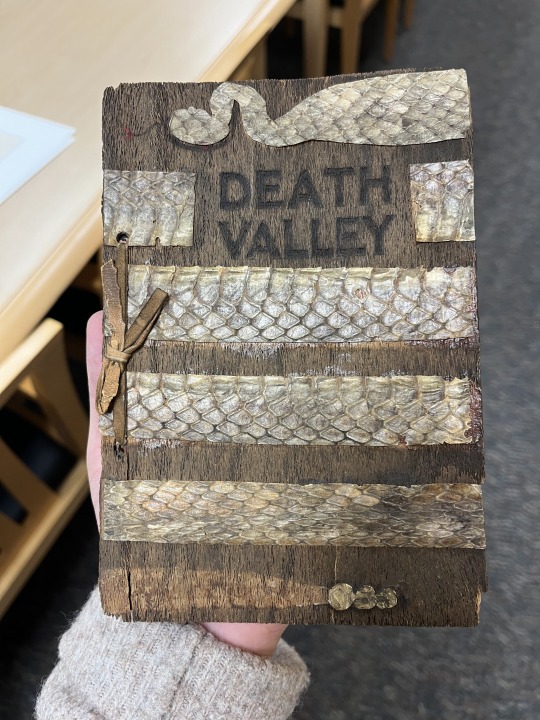
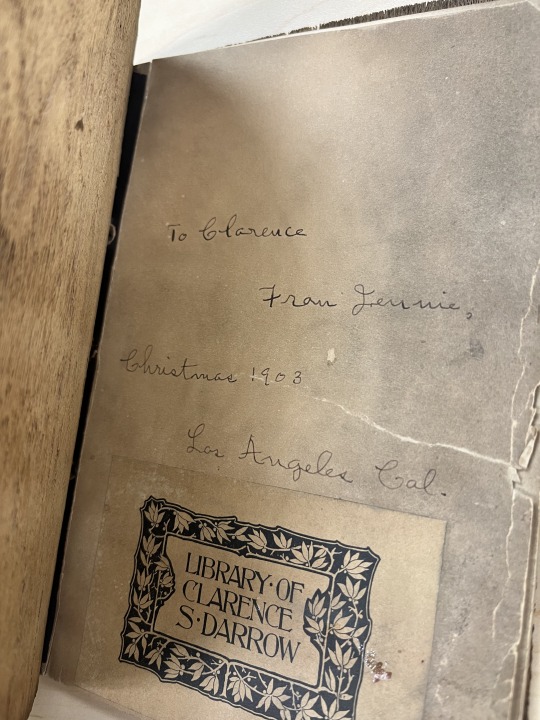


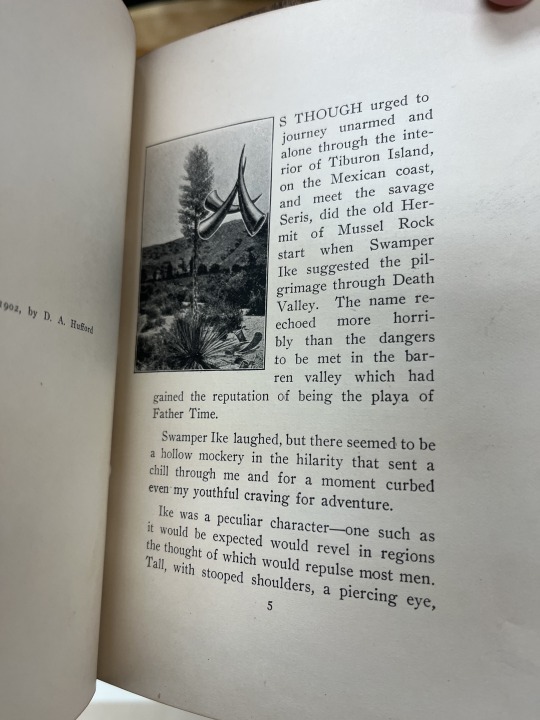
All I want for Christmas is a snakeskin book?
This copy of Death Valley: Swamper Ike's Traditional Lore: Why, When, How? was a Christmas gift to the famous American lawyer, Clarence Darrow, given to him by his sister Jennie in 1903.
We definitely think this is one of the most unique bindings in our collection. The thin wood boards feature strips of snakeskin in a coiled pattern (with a drawn-in tongue!) and the title is branded onto the cover, probably with hot iron.
The book describes an excursion from Los Angeles to Death Valley in 1901.
"Ike was a peculiar character--one such as it would be expected would revel in regions the thought of which would repulse most men."
#riesenfeld center#umn#university of minnesota law#university of minnesota law library#rare books#umn law#archives#special collections#law school#old books#clarence darrow#snake#snakeskin#western#book binding#death valley#christmas gift
43 notes
·
View notes
Text
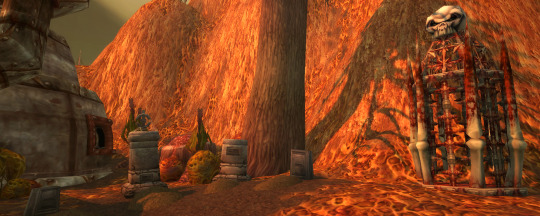
9 notes
·
View notes
Link
Check out the TV movie Powderkeg that served as the pilot for the series Bearcats! in my Rumble GUYWITHBEER CLASSIC TV channel.
#bearcats#bearcats!#tv movie#tv show#pilot episode#rumble#classic tv#70s tv#action#adventure#western#rody taylor#dennis cole#henry darrow#war#mexico
0 notes
Text

Barbara Stanwyck, Walter Huston, and Judith Anderson in The Furies (Anthony Mann, 1950)
Cast: Barbara Stanwyck, Walter Huston, Wendell Corey, Judith Anderson, Gilbert Roland, Thomas Gomez, Beulah Bondi, Albert Dekker, John Bromfield, Wallace Ford, Blanche Yurka. Screenplay: Charles Schnee, based on a book by Niven Busch. Cinematography: Victor Milner. Art direction: Henry Bumstead, Hans Dreier. Film editing: Archie Marshek. Music: Franz Waxman.
The Furies takes place in a West that never was: Would any real cattleman name his ranch "The Furies"? But that's because the film aims at the mythic, and darn near succeeds. The Furies of myth were goddesses of vengeance, also known as the Eumenides, which means "the gracious ones" -- they were so terrible that humans tried to placate them by calling them by a nice name. In the film, all of the women are to some degree vengeful: Barbara Stanwyck's Vance Jeffords chafes against the notion that because she's a woman, she can't run a ranch; Judith Anderson's Flo Burnett tries to get her hooks into Vance's father and bypass Vance's claim to his estate; Beulah Bondi's Mrs. Anaheim is the real power behind her banker husband; and the most vengeful of them all, Blanche Yurka's Mother Herrera, seeks justice for the hanging of her son. For a Western, it's also awfully talky, with some lines that sound like film noir: "I don't think I like love," says Vance. "It puts a bit in my mouth." Others are obvious attempts to sidestep cliché: Vance's father, T.C. (Walter Huston), tells her she has a "dowry if you pick a man I can favor, one I can sit down at the table with and not dislodge my chow." I suspect that a lot of the dialogue, as well as a lot of the slightly overcomplicated plot, comes from its source, a novel by Niven Busch, adapted by Charles Schnee: Busch knew his way around tough dialogue, having written the screenplay for one of film noir's classics, The Postman Always Rings Twice (Tay Garnett, 1946). Anthony Mann keeps the action from overwhelming the talk and the mythologizing, greatly helped by Stanwyck and Huston (in his final film) as the sparring but inextricably bonded Jeffordses. The movie could have used a stronger love interest than Wendell Corey as Rip Darrow, the man who wants to get the better of T.C., and woos Vance as part of the plot. Corey and Stanwyck don't strike sparks; she's more in tune with Gilbert Roland as Juan Herrera, the squatter on The Furies who has been her friend since childhood -- a subplot that's in some ways more interesting than the financial struggles to get hold of the ranch. Initially a box office failure, the film has grown in stature over the years as a showcase for some of the best work of Stanwyck, Huston, and Mann.
8 notes
·
View notes
Text
The Mark of Wolves - Red Rising fic
Drabble I
Drabble II
Lea
Waking up from a dreamless sleep, I open my eyes to the sight of Cassius snoring quietly on the durobag next to me.
I keep still, taking a moment to just watch the rise and fall of his chest. I can hear the regular breaths of two others in the room. The last member of our party of five is missing.
After Fitchner left yesterday, and Cassius didn’t come back, Roque and I had made our way back to the fort. Whatever the medBots had shot in me was prime stuff because I completed the trek on my own two feet, although I was half-asleep by the time Roque pushed me down on my pellet.
Cassius and the girls must’ve returned after us.
Sunlight streams through the window. It's the fourth day at the Institute. It’s my first morning—the first since what feels like forever, but has only been a day or two. Like so much else, I understand the concept of mornings and what they entail, but I can’t conjure up images to go with them. I’m curious what they look like.
Rubbing the last vestiges of sleep from my eyes, I sit up and survey the room. Quinn and Roque are resting on their own durobags. Lea’s durobag between them is empty.
My headache is completely gone and my sight is clear and sharp. A night’s sleep has done me good. My muscles are still sore, but I feel light and well-rested.
I find Lea in what once might have been the kitchen, preparing a simple breakfast of fruits, some bread and jam.
“Darrow, good morning!” She smiles brightly. “How are you feeling?”
“Prime. But hungry,” I admit, “This looks delicious. May I?”
“Of course! You’re the one who brought us bread, after all.” She recounts Orientation Day, how Cassius and I fought Ceres students, and how we’d succeeded in bringing some of the food during our escape. “Fortunately, we found these here.”
She shows me a clear durobag filled with a rustic survival box of iodine, the last of our food, a compass, rope, a toothbrush, and sulfur matches. So supplies have been hidden about the valley. Something tells me there are more important items hidden in the countryside than little survivor kits. Weapons? Transportation? Armor? Technology?
They can’t mean for us to make war with sticks and stones and metal tools. And if they don’t want us to kill each other, stun weapons must soon replace our metal ones.
I don’t know how the damn game is even played. So, information. I ask, “How big is the Institute?”
Lea picks the compass and I follow her outside. She puts the compass down in front of her when the needle points her feet north, picks a stick and starts drawing shapes on the ground.
My eyes narrow and then widen in realization.
She is drawing me a map.
A mountain range to the west. To the southeast, the woods. Dividing the two is a lush plain split by a massive southbound river, the Argos, and its tributaries. Farther south, past the plains and rivers, the ground dips away into bushes. “Marshes,” Lea explains.
Two rivers in a forested valley split our northern territory, which is at the edge of a vast wilderness. They form a V pointing southwest to the lowlands, where they eventually form one tributary to the Argos. Surrounding the valley are the highlands.
She draws two towers and a castle. “This is where our House is located. This is Phobos.” It lies in the far southwest of our territory. The second tower stands northwest where the two rivers meet in the valley to form their V. It crowns a distant dwarf mountain range. “And here is Deimos.”
The eastern river is called the Furor. The western, which runs just south of our castle, is the Metas. A single bridge spans the Metas. An enemy would have to cross it to enter between the V into the valley and strike northeast across easy, wooded ground to reach our castle.
In the southern plains, another castle. House Ceres. They might be exposed but they have crops and orchards inside their castewalls. No siege will bother them.
I commit the map to memory and thank Lea. She smiles sweetly. Everything about her is soft and sweet. She reminds me of fruit. Of the peaches we just ate. She’s so different from athletic Cassius, bold Quinn, even dependable Roque. What is someone like her doing here?
When she wants to go out and gather more food, I offer to accompany her.
She blinks rapidly, mouth opening and closing a few times. I’ve surprised her again.
We go south.
Yesterday, I was too busy putting one foot in front of the other to notice the beauty of the place. Now, I let my eyes rove. I drink up the world.
Lea teaches me the names of birds, of insects, and plants and trees. Shows me how to distinguish between the poisonous and edible mushrooms and berries.
On our way back, we decide to take a short break in a small clearing. Sitting side by side, she tells me how to read the time by watching the position of the sun in the sky. It’s hard, mainly because I don’t like looking up.
On Mars, the stars shine bright during the day too. I squint at the star-speckled sky and don’t know why the sight of its vastness makes my stomach tie itself in a knot.
It’s so beautiful it terrifies me.
Lea falls quiet and eventually dozes off on my shoulder. I sit here a while, listening to the passerine birds. I close my eyes.
The world is strange and frightening and resplendent. So different from the void in my head, the hollowness in my chest. It feels like someone’s cut me open and scraped out everything that gave my life shape.
My thoughts confuse me. They send me conflicting messages. I cannot trust my instincts. Flee. Kill. Run. Fight. I have so many questions. They fill my head. A buzzing hivemind.
I don’t know which one’s worse; the noise, or the pressing emptiness.
I think only in the present, live only for the close future. The past is gone, except for sudden spikes of feelings—fear, grief, rage, mostly—that leave my heart a stuttering mess. I keep wanting to claw out of my skin, wishing for someone to split my head open and sort through the chaos in there.
But it’s not all bad.
I might not fully have recovered, but I’m on my way there. Lea’s head is a comforting weight on my shoulder. The sun beats strongly overhead. The wind is refreshingly cool on my skin. My friends are waiting for me.
It feels bloody good to know where you are in the world.
#red rising fanfic#red rising fic#darrow au andromedus#lea#cassius au bellona#if you wanna know how i see these two#imagine a big mean dog and a sweet little kitty#btw there're some chunks missing from the drabble but#i'll add them later in chapter 2 on ao3
10 notes
·
View notes
Text
A very cool thing that an adaptation could add to Red Rising is people talking in different, not in use languages, so that they ensure a level of secrecy, especially at parties, galas and other events.
For example, I believe Roses would be educated into romance languages (we all know oppressive systems have no imagination whatsoever), but use a completely different language for their spywork - like korean (it has the most words out of every language, I believe it would be helpful for communication).
Golds are educated in Latin and Old Greek, but Darrow learnt in some other languages as well. Idk, I just think it'd be cool to have that. Especially languages you don't really hear in western media.
14 notes
·
View notes
Text
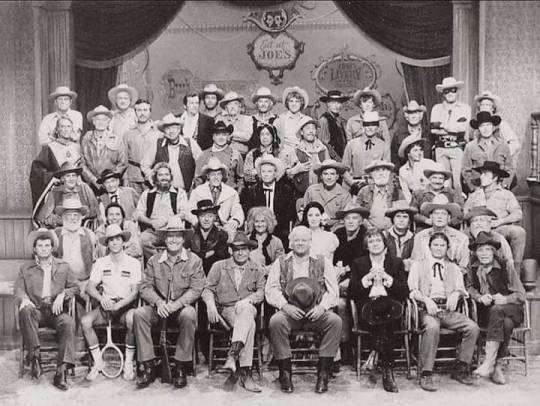
Here ya go:
WHEN THE WEST WAS FUN
A Western Reunion
Original air date 1979
Directed by Walter C. Miller
Written by Fred Putman
Set in a western saloon, Glenn Ford hosted a gathering of western television and film series stars including cast members from The Lone Ranger, The High Chaparral, The Virginian, Lawman and many others. This special event program brought ABC-TV its highest ratings of 1979. If you grew up on westerns like we did, (and despite the campy dialogue) it was fun to reminisce about those cherished childhood heroes with the stars who played them.
Front Row: Dewey Martin, Johnny Crawford, Chuck Connors, Glenn Ford, Alan Hale Jr., Henry Darrow, Larry Storch, Neville Brand.
2nd Row: Denver Pyle, Iron Eyes Cody, Harry Lauter, Jeanette Nolan, Linda Cristal, John Ireland, Mark Slade, Joe Bowman, Fred Putnam. 3rd Row: Pat Buttram, Milburn Stone, Dan Haggerty, Guy Madison, Rex Allen, John Bromfield, Keenan Wynn, Jackie Coogan, George Montgomery. 4th Row: X Brands, Bill Williams, Michael Ansara, Slim Pickens, Dick Jones, Don Diamond, Ken Curtis, John Russell, Peter Brown, James Drury. Back Row: Rod Cameron, Jock Mahoney, Jack Kelly, Tony Young, John McIntire, Ty Hardin, Darby Hinton, Lee Van Cleef, Will Hutchins, Terry Wilson, Clayton Moore, Doug McClure.
1 note
·
View note
Text


Joseph Kuenzer II House
2345 Rockside Rd.
Seven Hills, OH
Seven Hills, Ohio, is in the western part of Original Independence Township, which was organized in 1814. In its early years, the township economy was based on agriculture and stone quarrying. The northern part of modern Seven Hills is underlaid by a thick layer of high-grade sandstone, which was highly prized for grindstones back then. Hundreds of people were employed in quarrying thousands of tons of sandstone, which were also used as building and pavement materials. The sandstone was shipped by canal or drawn by wagons to Cleveland.
In 1848, Joseph Kuenzer opened a quarry on what is now Rockside Road between modern Kuenzer Drive and Broadview Road. Later, a steam-powered lathe was opened on the neighboring Darrow property to cut grindstones. The name “Rockside” refers to the ledge of sandstone that was quarried along that road. The Joseph Kuenzer II House is located within a copse of trees at 2345 Rockside Road in Seven Hills. Built in 1883, it was listed with the National Register of Historic Places on August 13, 1974. It is a 3,300 square foot house on a 0.93 acre lot with 5 bedrooms and 2.5 bathrooms.
0 notes
Photo

Maurice Darrow Bean (September 9, 1928 – November 30, 2009) was a career diplomat nominated by President Jimmy Carter to serve as Ambassador to Burma. He was born in Gary. His father Everett worked as a laborer for the U.S. Steel Corporation; his mother Vera was a housewife. He graduated from Howard University with a BA in government. His career in the US Foreign Service began when he was assigned to work with the Economic Cooperation Administration in Indonesia. He served in Djakarta, the nation’s capital, as a clerk, assistant program officer, and program analyst for the ECA. He continued his training, graduating from Haverford College with a MA in social and technical assistance. He received a postgraduate certificate in Advanced International Studies from Johns Hopkins University. He joined the newly formed Peace Corps and worked in Manila. He served first as the Corps Operations Officer (1961-1963), then Deputy Regional Director (1963-1964), and finally Operations Director (1964-1966). He rejoined the State Department as a director within the Bureau of East Asian and Pacific Affairs for Malaysia and Singapore. His mission ended in 1970, the year he came back stateside to participate in the nine-month senior seminar in foreign policy. He was assigned as Consul in Ibadan, Nigeria, serving there until 1973. From 1973 to 1976 he was Deputy Chief of Mission and Senior Foreign Service Inspector in Monrovia. While stationed in Ibadan, he married Dolores J. Winston in 1972. He became the first African American ambassador to serve in Southeast Asia. From 1977 to 1979, he worked closely with Burmese President Ne Win, and with leaders in neighboring countries, such as Thailand’s Kriangsak Chamanan, to contain drug trafficking and stop the cultivation of cocaine and heroin. He served as Diplomat-in-Residence at Case Western Reserve University. He was an adviser to the Commander of Air University in Maxwell Air Force Base. He retired from public service in 1986 in Pasadena, shortly after the death of his wife Delores. He was survived by his only son, Everett Thomas Bean. #africanhistory365 #africanexcellence #omegapsiphi https://www.instagram.com/p/CiSHpqZuyFTjI3GF7YKU_YHu1X_DGhatAwmJnU0/?igshid=NGJjMDIxMWI=
0 notes
Text
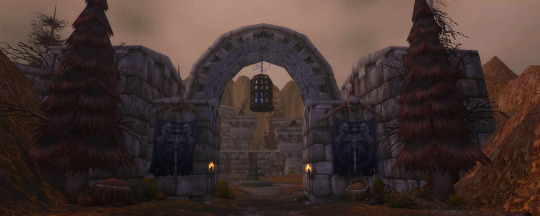
4 notes
·
View notes
Photo


Gauda Prime Day Calendar 2020 Masterpost
Soooo.... today’s post might require a bit of explanation.
As you can see, these are the Darrow-Westerns by Gillian Taylor, who’s name may already be ringing bells, if the blatant “Darrow” doesn’t. These make up a B7-avatar-in-pro-books series, of which Fanlore only lists the first two, presumably as by the time the author said what is quoted on Fanlore on the B7 Avatars page regarding these, the last two hadn’t come out yet. Above are the volumes in order: Darrow’s Law - Darrow’s Word - Darrow’s Badge - Darrow’s Gamble. As far as I could find out, these are all of them, and the last one does bring the series to a decent end point.
I had to jump through hoops to get these second hand, as especially the first two are very out of print, but they were so worth it. Everything I will say about these will sound like I’m joking, but I swear I am 100% serious. If people think KtD is blatantly an avatar novel, I don’t know what these are, because they are absolutely, definitely worse - or better, from the perspective of a B7/A/V fan.
Our setting: Not long after the American civil war, Govan, Wyoming. Meet small-ish town Sheriff Beauchief Darrow and his Deputy Hugh Keating, who are better friends than they like to admit and have (occasionally very personal) adventures together. Darrow is a displaced, educated former South State citizen, who takes his law seriously, but sees no issue with embezzling a few funds on the side; Hugh is a no less displaced English aristocrat, who is “not a lord” with a talent for card tricks and locks.
Long post, so cut here.
You will also meet some other familiar characters as the series progresses (such as a certain Pacey) - most of the male crew members appear in some shape or form, the women are a little short-changed in terms of B7, but there is a interesting female villain in one book and there is Vila’s Hugh’s love interest, who is a well written character who I’m not entirely sure is inspired by B7 but may be.
Either way, I genuinely enjoyed all of these deeply, and they are a special treat for A/V fans. While there is no real slash content, they are very close friends and the dynamic is pretty much unchanged from the A-V dynamic (or perhaps the IRL-Darrow-Keating dynamic, who knows, though the character traits are definitely more A-V). I will also say that the dynamic across the entire series also reminds me a lot of the Holmes-Watson(-Mary) dynamic in the ACD books, if that means anything to anyone, the kind of bachelor roommates - friends close enough to be family - supportive female love interest aspect. Darrow’s sexual orientation remains unspecified, though there is the B7-typical not-really-flirting with a certain female villain.
These are not complex stories and the plots are somewhat formulaic in structure, but varied enough in actual content to remain enjoyable across all four books (basically, there is always a showdown at the end, but the way there varies). It’s less of an in-depth character study series and more of fast-reading series, but for B7 fans especially there are so many lovely moments, KtD more than pales by comparison.
Content Note: I will say that because these are Westerns, there is definitely period-typical racism and I’m not sure how I feel about Darrow being a former land owner, so I cannot swear to it being “just” period-typical racism, as some villains are also POC, both of which are definitely authorial choices. I didn’t feel it was horribly in-your-face racism, as all the POC villains particularly were generally also well-written characters, but it may be something that impacts your decision to chase these down, so it needed mentioning.
Personal, B7-, fannish-, A/V-related highlights that I tried to keep mostly spoiler free:
The first three novels have more of an overarching arc regarding Hugh, which kinda concludes in the third one, leaving the fourth one more focussed on Darrow. All of the books have a “town development” kinda arc. I probably most enjoyed the 2nd and 4th.
Darrow‘s Law: The villain here may or may not be Servalan. This has many nods towards B7, but more on the subtle side.
Darrow’s Word: Featuring: Darrow and Hugh being snowed in during a blizzard, lots of lovely h/c (more, please!), even more domesticity, and Hugh gets a kitten.
Darrow’s Badge: Hugh’s family, best man Darrow, and things getting far too personal on Hugh’s end.
Darrow’s Gamble: is pretty much Rumours, with some AU twists. It is the one in the series that gets the most personal for Darrow and *may* be my favourite.
#blake's 7#kinda#b7 avatars#darrow westerns#b7 advent calendar#b7 ac 2020#kerr avon#vila restal#avon/vila#otp: thief and safe#whatever i'll tag it because it is
21 notes
·
View notes
Photo




Gifs from The High Chaparral episode Shadow of the Wind that didn’t make it into my previous post. I had to redo the tub gif to get it under the 10 MB size limit.
#The High Chaparral#thehighchaparral#henrydarrow#Henry Darrow#Cameron Mitchell#cameronmitchell#manolitomontoya#buckcannon#Mark Slade#markslade#bluecannon#gifs#westerns
6 notes
·
View notes
Text

The late Henry Darrow - Enrique Tomás Delgado Jiménez - The High Chaparral.
#henry darrow#the high chaparral#actor#western#tv#movie#character inspiration#character#cowboy#guns#old west#weird west#puerto rico
14 notes
·
View notes
Photo

(1968)
#The High Chaparral#comic#1968#Western#comic book#High Chaparral#Gold Key#comic cover#Apache#cowboy#comics#1960s#TV#Big John Cannon#Henry Darrow#Leif Erickson#Manolito Montoya
38 notes
·
View notes
Text

African culture in the Americas
In Darrow, Louisiana at the Ashland-Belle Helene Plantation historians and archeologists unearthed Kongo and West-Central African practices inside slave cabins. Enslaved Africans in Louisiana conjured the spirits of Kongo ancestors and water spirits by using sea shells. Other charms were found in several slave cabins, such as silver coins, beads, polished stones, bones, and were made into necklaces or worn in their pockets for protection. These artifacts provided examples of African rituals at Ashland Plantation. Slaveholders tried to stop African practices among their slaves, but enslaved African Americans disguised their rituals by using American materials and applying an African interpretation to them and hiding the charms in their pockets and making them into necklaces concealing these practices from their slaveholders.

In Talbot County, Maryland at the Wye House plantation where Frederick Douglass was enslaved in his youth, Kongo related artifacts were found. Enslaved African Americans created items to ward off evil spirits by creating a Hoodoo bundle near the entrances to chimneys which was believed to be where spirits enter. The Hoodoo bundle contained pieces of iron and a horse shoe. Enslaved African Americans put eyelets on shoes and boots to trap spirits. Archeologists also found small carved wooden faces. The wooden carvings had two faces carved into them on both sides which was interpreted to mean an African American conjurer who was a two-headed doctor. Two-headed doctors in Hoodoo means a person who can see into the future, and has knowledge about spirits and things unknown.
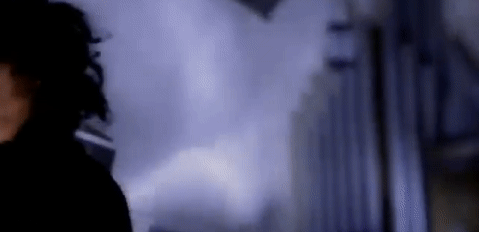
At Levi Jordan Plantation in Brazoria, Texas near the Gulf Coast, researchers suggests the plantation owner Levi Jordan may have transported captive Africans from Cuba back to his plantation in Texas. These captive Africans practiced a Bantu-Kongo religion in Cuba, and researchers excavated Kongo related artifacts at the site. For example, archeologists found in one of the cabins called the "curer's cabin" remains of an nkisi nkondi with iron wedges driven into the figure to activate its spirit. Researchers found a Kongo bilongo which enslaved African Americans created using materials from white porcelain creating a doll figure. In the western section of the cabin they found iron kettles and iron chain fragments. Researchers suggests the western section of the cabin was an altar to the Kongo spirit Zarabanda.

On a plantation in Kentucky called Locust Grove in Jefferson County, archeologists and historians found amulets made by enslaved African Americans that had the Kongo cosmogram engraved onto coins and beads. Blue beads were found among the artifacts, and in African spirituality blue beads attract protection to the wearer. In slave cabins in Kentucky and on other plantations in the American South, archeologists found blue beads and were used by enslaved people for spiritual protection. Enslaved African Americans in Kentucky combined Christian practices with traditional African beliefs.

The word "goofer" in goofer dust has Kongo origins, it comes from the "Kongo word 'Kufwa' which means to die." The mojo bag in Hoodoo has Bantu-Kongo origins. Mojo bags are called "toby" and the word toby derives from the Kongo word tobe. The word mojo also originated from the Kikongo word mooyo. The word mooyo means that natural ingredients have their own indwelling spirit that can be utilized in mojo bags to bring luck and protection. The mojo bag or conjure bag derived from the Bantu-Kongo minkisi. The Nkisi singular, and Minkisi plural, is when a spirit or spirits inhabit an object created by hand from an individual. These objects can be a bag (mojo bag or conjure bag) gourds, shells, and other containers. Various items are placed inside a bag to give it a particular spirit or job to do. Mojo bags and minkisis are filled with graveyard dirt, herbs, roots, and other materials by the spiritual healer called Nganga. The spiritual priests in Central Africa became the rootworkers and Hoodoo doctors in African American communities. In the American South, conjure doctors create mojo bags similar to the Ngangas minkisi bags as both are fed offerings with whiskey.

Other examples of Kongo origins of the mojo bag is found in the story of Gullah Jack. Gullah Jack was an African from Angola who carried a conjure bag (mojo bag) onto a slave ship leaving Zanzibar for the United States. In South Carolina, Gullah Jack used the spiritual knowledge he had with him from Angola and made protective charms for other enslaved people for their spiritual protection.

Other Bantu-Kongo origins in Hoodoo is making a cross mark (Kongo cosmogram) and stand on it and take an oath. This practice is done in Central Africa and in the United States in African American communities. The Kongo cosmogram is also used as a powerful charm of protection when drawn on the ground, the solar emblems or circles at the end and the arrows are not drawn just the cross marks which looks like an X
#african spirituality#african#afrakan#kemetic dreams#brownskin#afrakans#africans#african culture#afrakan spirituality#fitness#afrakan woman#cuba#kongo#hoodoo#bantu#african american#cross#crossroads
424 notes
·
View notes
